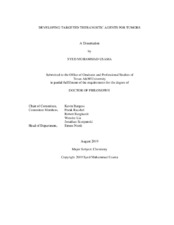| dc.description.abstract | Optical imaging is most favorable for dyes that absorb in the near-IR region because tissue is more permeable to light >750 nm. A particular set of cyanine dyes localize and persists in almost all solid tumors (e.g. glioblastoma, hepatocellular carcinoma, non-small lung cancer, breast cancer etc) for days, relative to healthy tissue. Remarkably, these tumor seeking dyes also absorb above 750 nm (in near-infrared region, NIR) where penetration of light is at maximum (up to 10 mm). Early work described in this dissertation focuses on conjugation of a small molecule which targets TrkC+ cancer cells, overexpressed in metastatic breast cancer, with a near-infrared zwitterionic cyanine dye for deep tumor imaging. The newly developed probe maintained the specific targeting to TrkC+ 4T1 metastatic breast tumor cells as well as TrkC+ metastatic breast tumor tissue. However, as the work progressed, we shifted our attention to using tumor seeking dyes as delivery agents, i.e. formation of theranostics for optical imaging and therapy. This dissertation presents mechanistic work to exploring reactions of these tumor seeking dyes with different nucleophilic amino acids. It was observed that only thiol presenting amino acids (i.e. cysteine) substitute the meso-chlorine of these dyes under physiological conditions. Human serum albumin, the most abundant protein in the human body, and other thiol presenting proteins were also labeled by this technique.
This dissertation explores the possibility of covalently binding a fluorophore for in vivo optical imaging to a kinase inhibitor (dasatinib) where the particular fluorophore chosen for this study, a heptamethine cyanine (Cy) derivative, tends to accumulate in tumors. Our preliminary results are promising; we have been able to, (i) enhance the IC50 of KI after conjugating with tumor seeking dyes; and, (ii) deliver KI specifically to cancer cells over normal cells. This dissertation also discusses work on synthesizing a small library of iodine incorporated tumor seeking dyes for PDT with absorbance around 800 nm region and good photophysical properties. The N-substituents of these cyanines were varied to adjust their charges and polarities, and to accommodate conjugation to other entities (e.g. biomolecules or fragments to expand their theranostic modalities). Thus, it was possible to optimize their photocytotoxicities without compromising their other desirable characteristics for PDT. | en |


